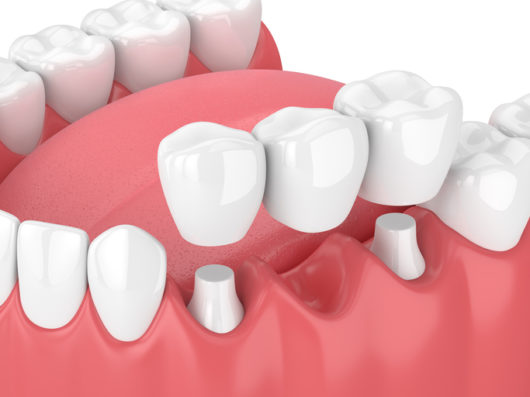 Broken teeth can increase the risk of gum disease. Bacteria may accumulate in the broken teeth and eventually infect the gums. Once that happens, the disease quickly spreads to other areas of the gum and other teeth in the mouth. As advanced periodontal disease can be very difficult to treat, dental bridges are more than just cosmetic.
Broken teeth can increase the risk of gum disease. Bacteria may accumulate in the broken teeth and eventually infect the gums. Once that happens, the disease quickly spreads to other areas of the gum and other teeth in the mouth. As advanced periodontal disease can be very difficult to treat, dental bridges are more than just cosmetic.
Of course, the cosmetic advantages of a dental bridge are also significant. An uneven smile can erode self-confidence and significantly affects personal and professional relationships.
Types of Dental Bridges
Most people are good candidates for dental bridges. Patients must be in good general health. Specifically, the teeth on either side of the bridge must be in excellent condition. Dental bridges work best for people who have two or more broken or missing teeth in the same area of their mouths.
There are several types of bridges. Each type of dental bridge has pros and cons, as outlined below. The most common ones are:
- Maryland: Dr. Stone typically uses adhesive bridges if the patient is only missing one tooth. This procedure may also be available for multiple missing teeth. Basically, resin wings support a porcelain crown. A Maryland bridge is minimally invasive and requires almost no preparation.
- Cantilever: Some people only have one healthy tooth adjacent to the bridge. In these cases, a cantilever bridge is the best option.
- Traditional: The most common type of dental bridge consists of dental crown(s) and one or more pontic (artificial) teeth. These bridges are strong as well as good-looking. So, they’re ideal for both front teeth and molars.
- Implant-Supported: Dental implants support the bridge, as opposed to porcelain crowns or metal abutments. Implant-supported bridges are usually the most natural-looking and best-fitting dental bridges.
Some Dental Bridge Pros and Cons
Dental bridges are often the most cost-effective solution for broken and missing teeth. The procedure, except for implant-supported bridges, is generally rather fast and relatively non-invasive. Dr. Stone may prepare the teeth by removing some of the enamel. But there’s never any need for bone grafting or other advanced procedures.
However, bridges can strain remaining teeth, especially the ones that support the bridge. That additional pressure means that in some cases, dental bridges are temporary solutions. Luckily, “temporary” usually means at least several years, or maybe even a decade. Moreover, bridges do not address any underlying problems, such as early-stage gum disease.
During your initial consultation at Best Dental Associates, Dr. John Stone will thoroughly review all the dental bridge pros and cons. Chances are good that this cost-effective, long-lasting, and minimally-invasive procedure may be right for you.
https://www.dhsv.org.au/dental-health/teeth-tips-and-facts/periodontitis



